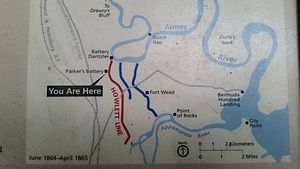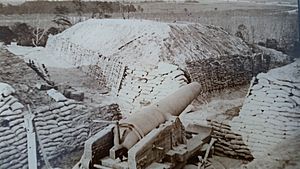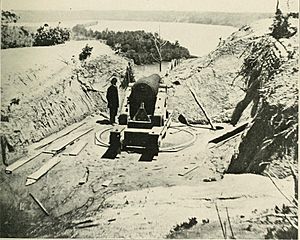Howlett Line facts for kids
The Howlett Line was a very important set of earthworks (like big dirt walls) built by the Confederate soldiers during the American Civil War. It was dug in May 1864 as part of the Bermuda Hundred campaign. This line of defenses stretched across a piece of land called the Bermuda Hundred peninsula. It went from the James River all the way to the Appomattox River.
The line got its name from Dr. Howlett's House, which was near the James River at one end of the defenses. The Howlett Line became famous for being like a "Cork in the Bottle." It stopped a large Union army, led by General Butler, from moving forward. This army, called the Army of the James, had about 30,000 soldiers.
Contents
Building the Howlett Line
After the Battle of Ware Bottom Church on May 20, 1864, the Confederate soldiers started digging these important defenses. This new line became known as the Howlett Line. It was about three miles long, stretching from one river to the other.
The main goal of the Howlett Line was to protect a very important railroad and a main road. These routes connected the cities of Richmond and Petersburg. At that time, these cities were not very well protected. General Daniel H. Hill was in charge of building these strong Confederate defenses.
The "Cork in the Bottle" Idea
General Ulysses S. Grant, a famous Union leader, once talked about General Butler's situation. He spoke with his Chief Engineer, General John G. Barnard.
General Barnard explained that General Butler's army was in a very strong position. It was between the James and Appomattox rivers. He said that Butler could hold this spot for a long time, even with fewer soldiers. However, he also said that Butler could not attack from there.
General Grant then asked why Butler couldn't move out and cross the Richmond and Petersburg Railroad to get behind Richmond. General Barnard replied that it was impossible. He explained that the enemy (the Confederates) had built a strong defense line right in front of Butler's.
Barnard then drew a picture to show what he meant. He said the position was like a bottle. Butler's line of defenses across the narrow neck of land was like the cork. The Confederates had built an equally strong line right in front of him. So, it was as if Butler was "in a bottle." He was safe from attack, but the Confederates had "corked the bottle." This meant a small Confederate force could keep Butler trapped there.
Key Parts of the Line
Two important forts, or "batteries," helped anchor the Howlett Line. One was Battery Dantzler, which was first called Howlett's Battery. It was later renamed to honor Colonel Olin M. Dantzler. The other was Parker's Virginia Battery.
During the Second Battle of Petersburg on June 15, 1864, General P. G. T. Beauregard needed more soldiers. He moved some troops from the Howlett Line to help defend his main positions. The Howlett Line successfully held General Butler's army in place. It continued to do so until General Robert E. Lee left the area on April 2, 1865.
Protecting the Howlett Line Today
The Chesterfield Historical Society of Virginia is working to preserve the parts of the Howlett Line that still exist. These historic earthworks are now part of the Howlett Line Park. This park belongs to the Chesterfield County Parks System.




